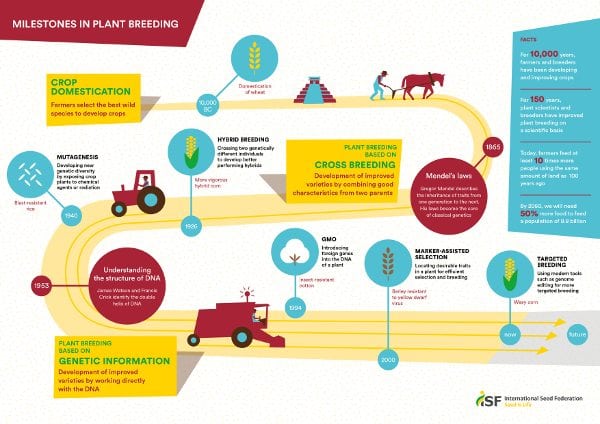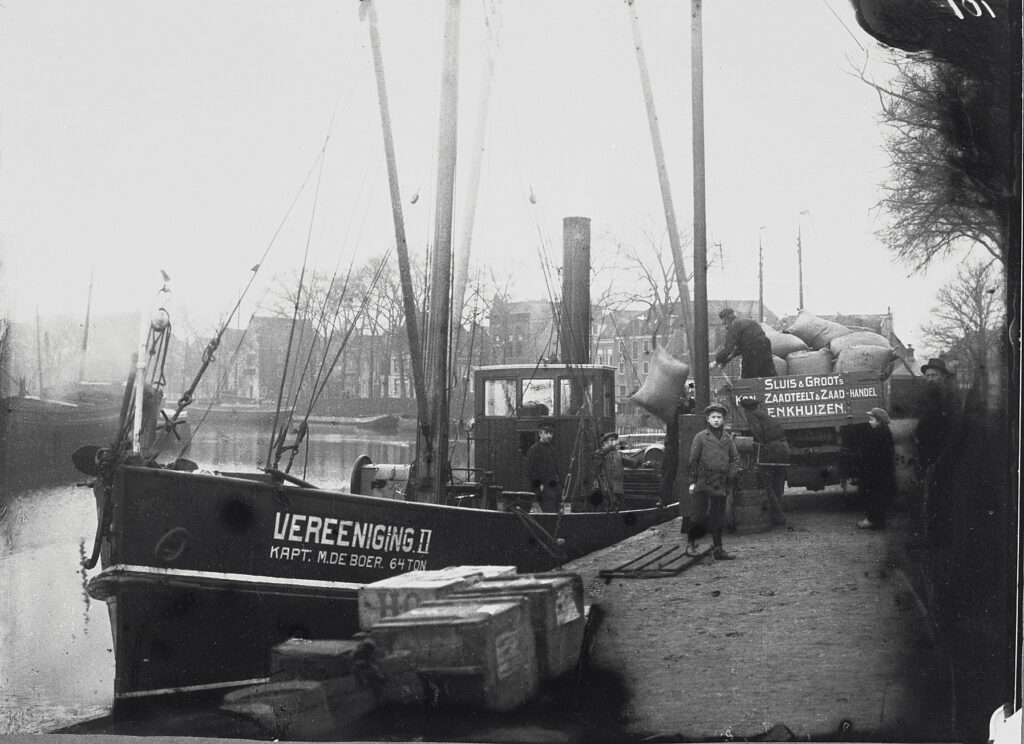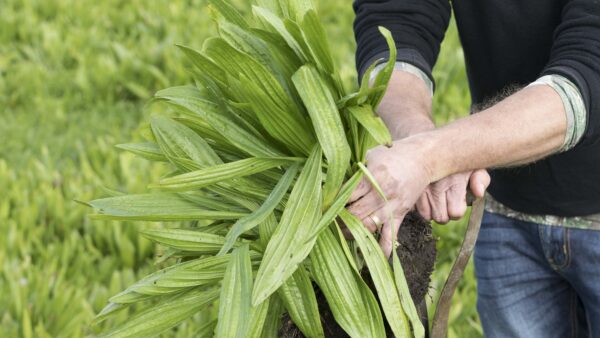Whether and how to regulate the resulting products of the latest plant breeding methods is a debate that is not only a hot topic in Europe, but also in many other countries and on a global level. To get more insight into the global views, European Seed asked the International Seed Federation (ISF) for their views on these important methods and how to overcome the regulatory divergence. We spoke with Michael Keller, ISF’s Secretary General and Jennifer Clowes, ISF’s Communication Manager to learn more about their efforts.
European Seed (ES): Michael why is it important for ISF and its members to participate in this debate?
Michael Keller (MK): ISF’s mission is to create the best environment for the global movement of seed and promote plant breeding and innovation in seed. The importance of plant breeding innovation is top of ISF strategic objectives, as we move towards consistent policies for products developed through the latest breeding methods to enable their use and to ensure uninterrupted trade. Without consistent, science-based policies, this is at risk, and this matters greatly to our members, and to other parts of the value chain, particularly commodities and grain trade, for whom international trade is also critical.
As the voice of the global seed industry, it is critical that ISF is positioned at the forefront of this debate, to cooperate and coordinate with national seed trade organisations worldwide and regional seed trade associations like ESA, as well as with governments, international organisations and stakeholders across the value chain. Outreach and communication are the two pillars of the ISF plant breeding innovation strategy.

For example, ideally, we want to avoid that a plant produced with gene editing methods is regulated in one country as a GMO and exempted from GM-regulation in another country. This patchwork of regulatory and policy environments creates uncertainty and stifles innovation globally, despite the relative accessibility and affordability of the tools.
[tweetshareinline tweet=”It is critical that policies on plant breeding innovation are consistent and at the same time foster innovation.” username=”EuropeanSeed”]
ES: To prevent stifling innovation and trade disruptions it would be good if international regulations in this field are aligned. How does ISF go about achieving this?
MK: As outreach is the key pillar of ISF’s strategy, we have been closely coordinating with our members on this topic for the last two years. More specifically, we have been coordinating with the national seed trade associations, and in partnership with the regional seed associations, to engage with governments and stakeholders across the value chain with the aim of achieving this alignment. The first step towards consistency is reaching agreement among governments on the criteria that will be used to determine the scope of regulatory oversight in their countries. The second step is to agree on the process used to determine whether a product falls within or outside the scope of existing biotechnology/GMO regulations.
[tweetshareinline tweet=”ISF is cooperating and coordinating with national seed trade associations efforts to engage with governments and stakeholders across the value chain to achieve alignment.” username=”EuropeanSeed”]
ES: Can you share some of the achievements? How is the progress towards aligning international regulations?
MK: Developed last year, the Consistent Criteria for the Scope of Regulatory Oversight concept paper has provided national seed associations with a roadmap for their discussions with their governments and stakeholders. An underlying principle for determining these consistent criteria is: “Plant varieties developed through the latest breeding methods should not be differentially regulated if they are similar or indistinguishable from varieties that could have been produced through earlier breeding methods.”
ISF has developed additional elements to support the implementation of the consistent criteria to facilitate alignment across countries, including definitions, standard information requests needed to make determinations, applied timelines and the recognition of other countries’ scope decisions.
Consistent implementation is critical to avoid global impacts that different processes may have on global seed movement, exchange and access to germplasm, agriculture, trade and research collaborations.
Jennifer Clowes (JC): Last year in collaboration with members of ASTA, ESA and CLI, ISF developed a robust communication toolkit designed to support ISF’s allies and partners in their outreach across their own networks, to their country’s policymakers and other public stakeholders. The toolkit includes:
- ‘Discussion Guide: How to talk about plant breeding innovation’ translated into French, Spanish, Portuguese and Chinese in 2017, with Japanese and Korean in the pipeline for 2018.
- Milestones and Benefits infographics: adapted and translated into other languages by national seed associations in The Netherlands (Plantum), France (UFS) and Germany (BDP), and used in their national communications. The infographics have been widely used in academia, including the University of Gent and the Danish Technology Institute, and have also proved to be a hit on social media.
Global PowerPoint slides: widely used by ISF allies and partners, including Crop Life International (CLI) and the European Seed Association (ESA), in their presentations to a range of stakeholders across the value chain.

Since the launch, ISF has continued to work closely with ASTA, ESA and CLI on a coordinated effort across national and international networks to promote consistency. This has worked particularly well across social media with the amplification of common messages, and the cross-promotion of the ASTA and ESA campaigns.
MK: In terms of engagement and cooperation, in December 2017, ISF together with the Chinese National Seed Association and the Chinese Seed Trade Association, organized an international workshop on gene editing in Beijing. The 80 participants included government representatives from China, representatives of the Chinese and international seed sectors, and public researchers from China and overseas. The workshop facilitated a dialogue on domestic and international policies and fostered understanding of the current status of public and private research.
What’s New in South America?
Argentina introduced the Regulatory Framework for Agricultural Biotechnology in 1991. The regulatory framework for GMO consists of regulations issued by the Secretariat of Agriculture, or more recently by the Secretariat of Bio-economy. The commercial release of a GMO is granted by the Secretary based on three independent reviews: Biotechnology Directorate supported by the National Advisory Commission on Agricultural Biotechnology (CONABIA), assessing biosafety of the agroecosystem; the National Service of Agrifood Health and Quality (SENASA), supported by the Food and Feed Safety Advisory commission, assessing food and feed safety, and; the Directorate of Agricultural Markets (DMA), assessing impact on trade and production. The regulatory framework was wholly revised in 2011 and it is updated on a regular basis.
Argentina was the first country in the world with a regulatory framework for products derived from New Breeding Techniques (NBTs). The Resolution 173/2015 was the outcome of a three-year debate into the CONABIA, which took into account NBTs and parallel discussions overseas. The Resolution does not alter the GMO regulatory framework, but rather establishes the procedure to determine in which cases a crop obtained by breeding techniques involving modern biotechnology does not fall under the current biosafety regulation. Applicants must submit the case for the assessment of CONABIA through a Previous Consultation Stage (ICP), providing the breeding methodology used to obtain and select the crop, the new characteristic introduced, evidence of the genetic changes present in the final product, and evidence of the removal of the temporary transgene used to obtain the product (if necessary). The consultation will define whether the result of the breeding process is a new combination of genetic material. A genetic change shall be regarded as a new combination of genetic material when a stable and joint insertion of one or more genes or DNA sequences that are a part of a defined genetic construct have been introduced permanently into the plant genome. The procedure has a 60-day time limit, at the end of which the applicant receives a reply from the authorities stating whether the product described falls under the GE regulation or not. The procedure is working fine, and a number of applications have been submitted – mainly targeted genome editions – and all the responses were delivered on time.
In Chile the Agricultural and Livestock Service of Chile (SAG), an official agency dependent on the Ministry of Agriculture, determined that it is not necessary to modify the current GMO regulations, but rather has set up a mandatory consultation process to determine, on a case-by-case basis, whether a particular product would fall under the current GMO regulations. During the consultation process, information provided by the developer about the biotechnological technique (method) is used, as well as the breeding scheme and the techniques used to discard the insertion of genetic sequences. SAG will indicate, within a period of 20 working days, if the product developed by any of the new biotechnological techniques (methods) of plant breeding, which is intended to be introduced into the national environment, is within or beyond the scope of the GMO regulation, which for this purpose means that the material is considered or not GMO, respectively.
The current Biosafety Law in Brazil was adopted in 2005. The National Biosafety Technical Commission (CTNBio) created a working group to study new breeding techniques such as gene editing as they relate to the scope of current Brazilian legislation and to propose a new normative if necessary. The normative was approved by CTNBio and published in January this year. Now Brazil has a new normative to evaluate products generated by the latest breeding methods. The strategy of the working group was to analyze the new advances in plant improvements; to have a legal framework that allows scientific advances while also assuring safety standards; and to analyze other countries’ experiences. The focus of normative approved is that products without the presence of recombinant DNA/RNA in progeny or with the presence of genetic elements that can be obtained by conventional breeding should not be considered GMOs. Under the new consultation procedure developers provide information on the product, including the methods used to generate the product and showing the absence of recombinant DNA/RNA in the progeny.
The way of dealing with this topic in Argentina, Chile and Brazil shows the convergence or consistency in the use of gene editing to make deletions, or other changes that do not result in a “novel genetic combination”. Both Chile and Brazil are following Argentina’s criteria.
Elsewhere, other countries, such as Australia, South Africa and Japan, have not yet determined whether or how current domestic GMO regulations would apply to the latest breeding methods, but ISF has the strong feeling that countries are seeing the importance of consistent regulation.
To bring further clarity to the dialogue, ISF is in the process of preparing a position paper on plant breeding innovation for adoption at the ISF World Seed Congress in Brisbane (3-6 June 2018). At the same time ISF is working on a set of guiding principles for information and communication that will be used for further engagement with the value chain.
Where on the Web: http://www.worldseed.org/our-work/plant-breeding/plant-breeding-innovation/
Editor’s Note: The International Seed Federation (ISF) is a non-governmental, non-profit making organization, has represented its members’ interests since 1924 and is widely regarded as the voice of the global seed industry.













